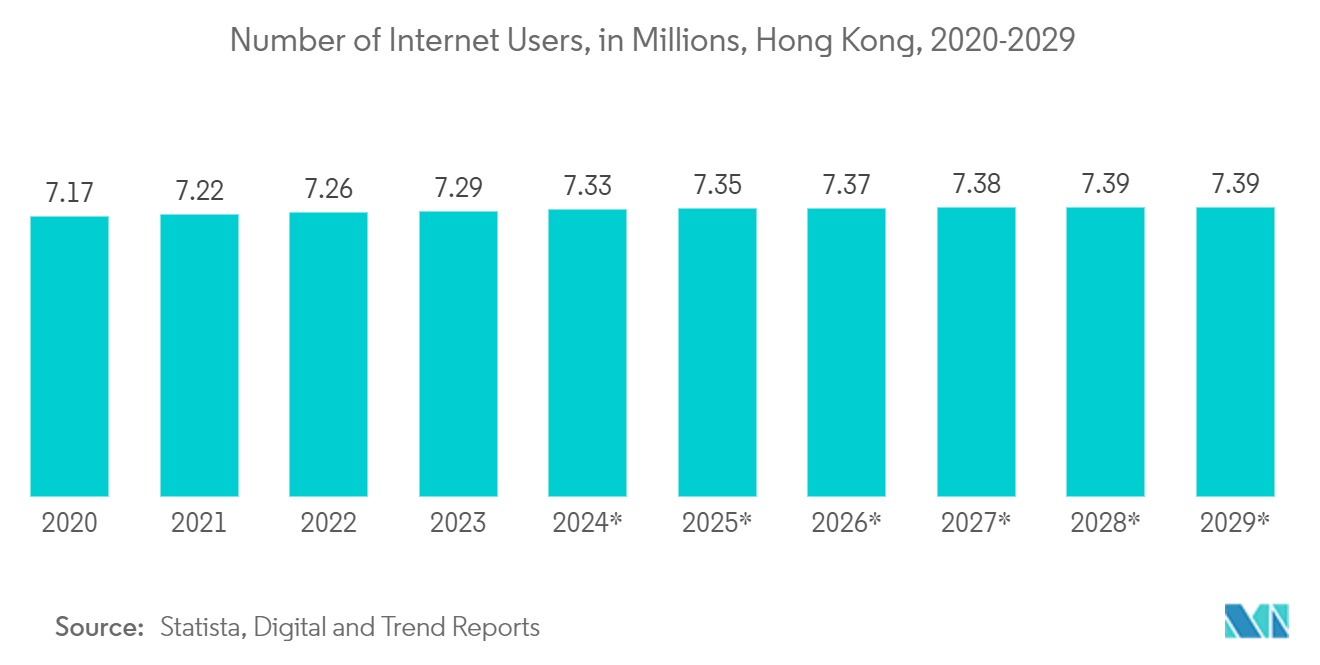Market Trends of Hong Kong Data Center Networking Industry
IT & Telecommunication Segment to Hold Major Share in the Market.
- The demand for the cloud segment is expected to increase with the growing demand for analytics, visualization tools, and business services. Also, the Increasing adoption of cloud-based services is driving the expansion of hyperscale and wholesale colocation services in Hong Kong, resulting in increased demand for space in data centers and, consequently, the need for more network devices and services within data centers.
- With 5G being introduced in the country, high bandwidth speeds offered led to users opting for multiple smart devices, such as smart wearables, tablets, security systems, smart lighting, and others, which have catalyzed the demand for these devices. Around 96% of the population in Hong Kong currently uses smartphones to access the internet on a daily basis.
- To meet the surplus demand, automation has to be introduced in the industry as per Industry 4.0 measures. Increasing demand for streaming services, financial services, and smart home automation applications is expected to further catalyze data consumption.
- Users of smart devices, use their smartphones and tablets for streaming, browsing, and playing games, which has led to consumers opting for 4G services, thus diminishing the 3G service market over the years. The implementation of 5G is expected to further increase the data speed with the evolving technology over the years, which is expected to cater to the demand as more industries adopt automation in their companies in the manufacturing sector. Such improvements in the market are expected to create more demand for data center servers in the coming years.
- The Minister of Posts and Telecommunications announced the ministry's plans to connect 2,715 kilometers of submarine fiber optic cable network from Hong Kong to Preah Sihanouk. The project was initiated in 2022 and will be completed by 2024. Such developments are expected to increase the adoption of data storage solutions and positively impact market growth.

Ethernet Switches Holds Largest Market Share
- Data Center Ethernet switches are network devices that operate in a data center environment. In order to facilitate the efficiency and rapid transfer of data, they play an essential role in establishing interconnection between servers, storage devices, or other network equipment at a data center. Switches are designed for high-speed data transmission with support for gigabit and multigigabit Ethernet, including 10 GbE, 25 GbE, 40 GbE, 100 GbE, and beyond.
- Hong Kong is a major center for finance in Asia. Data centers are essential for high-frequency trading and financial transactions that characterize the industry, supported by robust Ethernet switches. To operate in the Financial Industry, latency and high-throughput switches are essential.
- Further, Hong Kong has an increasing demand for cloud services and hosting solutions. In data centers that provide cloud computing services, Ethernet switches play a vital role in supporting the infrastructure companies require to house applications, store information, and access IT resources from remote locations.
- In addition, the smart city initiatives of Hong Kong require a resilient and efficient information technology infrastructure. The development of smart city applications and supporting network needs for technologies that increase the quality of life, transport, or municipal services are supported by Ethernet switches.
- Moreover, the Increasing focus on digitalization, Internet penetration (reached 93.1% by the start of 2023 from 93% during the same period in 2022), Strong connectivity, and e-commerce sales across the country create more need for storage facilities, resulting in huge demand for data centers and consequently the need for more ethernet switches within data centers.
- The key players in the market focus on updating the network devices to meet the market demand. In June 2023, Cisco’s Nexus 9800 Series modular switches expand the Cisco Nexus 9000 Series portfolio with a new chassis architecture to include a combination of several first-generation line cards and fabrics modules, allowing it to scale from 57 Tbps up to 115 Tbps. Line cards that now offer 400 GE or 100 GE ports and higher speeds can be supported by each line card slot on the chassis.


